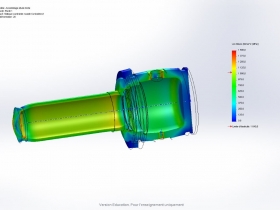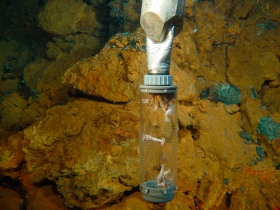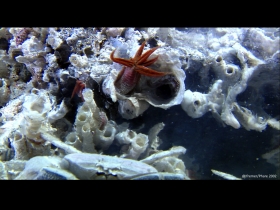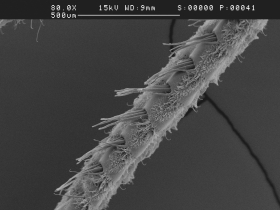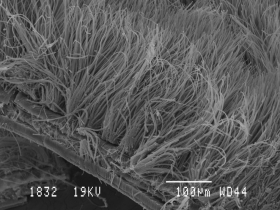AMEX - Adaptations to Extreme Environments
Our group studies Deep sea chemosynthetic environments, such as hydrothermal vents, hydrocarbon seeps. Sunken wood or whale carcasses are also of interest to us. These remote habitats are caracterized by their patchiness, their elevated biomass, and by peculiar physico-chemical environmental conditions. We study the biology of the endemic species inhabiting such environments, with a particular focus on their dominating symbiotic fauna. Several aspects are studied : the host-symbiont relationship, the sensory organs, the response(s) to thermal, chemical and pression variations. Many of these studies involve experiments on live animals, requiring work at in situ pressure in the lab. Therefore we are also implicated in the design and development of pressurised instruments.
The deep ocean is the largest environment on earth, and remains widely unexplored. Yet it is urgent to improve our knowledge on deep-sea habitats, which are threatened by future industrial exploitation of mineral resources, particularly in the case of deep-sea hydrothermal ecosystems. Our group studies responses of metazoans in the face of environmental perturbations (I) such as experienced at hydrothermal vent habitats (temperature, pressure, chemistry), and also the diversity and plasticity of chemosynthetic symbioses (II). The study of these dynamical phenomena requires observations and experiments on live animals, under controlled conditions, therefore justifying another direction of research : the design of pressurised equipments (III) (isobaric sampling cells and pressurised mesocosms).
I - Responses of metazoans in the face of environmental perturbations
- pressure : homeoviscous (lipid analyses) response following acclimation to changing depth
- temperature : response to heat stress (transcription and biochemical analyses) upon contact with the "hotspot" of the hydrothermal vent habitat.
- chemistry : study of olfaction properties with respect to chemical signals in the hydrothermal vent fluids / ecotoxicology studies in response to future industrial exploitation of mineral resources at deep-sea vent environments.
II - Diversity and plasticity of chemosynthetic symbioses
- symbioses in Arthropods (alvinocaridid shrimp), and molluscs (bivalves, gastropods ...) : structural, phylogenetical, and metagenomic analyses
III - Design of pressurised equipments
- Deep-sea organisms are impacted upon exposure to atmospheric pressure. The pressurised aquaria IPOCAMP, BALIST, and AbyssBox, and the isobaric sampling cell PERISCOP, allow to restore hydrostatic pressures prevailing at depth (down to 3000m for these instruments). Therefore they allow sampling and study of animals in a good physiological state.
Latest scientific articles
2024
-
. 2024. “Freshwater And Limno-Terrestrial Meiofauna Of The Massane Forest Reserve In The Eastern French Pyrenees”. Biogeographia – The Journal Of Integrative Biogeography 39 (1). doi:10.21426/B639162226. https://escholarship.org/uc/item/36v7z1xj.
2022
-
. 2022. “Careful Amendment Of Morphological Data Sets Improves Phylogenetic Frameworks: Re-Evaluating Placement Of The Fossil Amiskwia Sagittiformis”. Journal Of Systematic Palaeontology 20 (1): 1 - 14. doi:10.1080/14772019.2022.2109217. https://www.tandfonline.com/doi/full/10.1080/14772019.2022.2109217.
2021
-
. 2021. “Conservative Route To Genome Compaction In A Miniature Annelidabstract”. Nature Ecology & Evolution 5 (2): 231 - 242. doi:10.1038/s41559-020-01327-6. https://www.nature.com/articles/s41559-020-01327-6.
-
. 2021. “Do Hydrothermal Shrimp Smell Vents?”. Insects 12 (11). doi:10.3390/insects12111043.
-
. 2021. “Do Hydrothermal Shrimp Smell Vents? ”. Insects 12(11): 1043. doi:doi: 10.3390/insects12111043.
-
. 2021. “Interstitial Annelida”. Diversity 13 (2): 77. doi:10.3390/d13020077. https://www.mdpi.com/1424-2818/13/2/77.
2020
-
. 2020. “Advances In The Use Of Paris-Edinburgh Presses For High Pressure Neutron Scattering”. Journal Of Neutron Research 21 (3-4): 117 - 124. doi:10.3233/JNR-190120. https://content.iospress.com/articles/journal-of-neutron-research/jnr190120.
-
. 2020. “Lipidome Variations Of Deep-Sea Vent Shrimps According To Acclimation Pressure: A Homeoviscous Response?”. Deep Sea Research Part I: Oceanographic Research Papers: 103285. doi:10.1016/j.dsr.2020.103285. https://linkinghub.elsevier.com/retrieve/pii/S096706372030073X.
-
. 2020. “Rimicaris Exoculata: Biology And Ecology Of A Shrimp From Deep-Sea Hydrothermal Vents Associated With Ectosymbiotic Bacteria”. Marine Ecology Progress Series 652: 187 - 222. doi:10.3354/meps13467. https://www.int-res.com/abstracts/meps/v652/p187-222/.
Team members
Programs
| 2021 to 2025 | ARDECO |
| 2023 | BOCA |
| 2023 | MIRO |
| 2019 to 2021 | BENDICAM |
| 2019 | CROCS (Comparaison des Récepteurs Olfactifs chez la Crevette et la Seiche) |
| 2014 to 2017 | Co-financement These UPMC |
| 2017 | IPOCAMP Ocean Science Centre (Terre-Neuve) |
| 2016 | PERISCOP 6000 |
| 2014 to 2016 | MIDAS |
| 2013 to 2015 | ANR TF DeepEvo |




